
PLEASE NOTE: The Ajanta Site Seminar has been indefinitely suspended. When and if Dr. Spink decides to reinstate teh program, I will post information here!
This is a page of information and frequently asked questions
about the seminar. Please let us know
if you require more information.

WHAT IS THE SEMINAR?
The Ajanta Site Seminar is a program focused on the study
of the 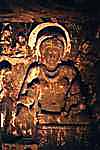 Ajanta
site. There are also supplemental trips to other nearby monuments if
there is time. The seminar is generally geared for students on a graduate
level, but everyone is welcome to apply; no degree or background is required.
You will be given information on background reading. There will be students
from all over the world participating, including India.
Ajanta
site. There are also supplemental trips to other nearby monuments if
there is time. The seminar is generally geared for students on a graduate
level, but everyone is welcome to apply; no degree or background is required.
You will be given information on background reading. There will be students
from all over the world participating, including India.
The seminar is wonderful opportunity to see great monuments
close-up and personal, get some training in religious studies, art history,
and archaeology, and learn a methodology for piecing together clues left
to us from the past.

WHEN IS THE SEMINAR?
The Ajanta Site Seminar usually meets in Fardapur in late
July. The bulk of the time is spent in Ajanta/Fardapur, with occasional
visits to other sites.
The Seminar has been suspended until further notice.
You should plan to arrive by Monday evening, and leave
by Sunday afternoon. The caves are closed on Mondays.
WHERE IS THE SEMINAR?
Most or all of the seminar is spent at the Ajanta site
itself. Participants stay in the MTDC Holiday Resort Hotel in Fardapur.
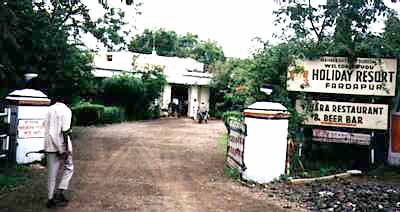
MTDC, Fardapur.
Fardapur is a small village very close to the caves. The
people there are mostly very nice and very interested in foreigners. In
the 1996 seminar, we took tours of the village, and the children followed
us in swarms! The village is rooted in an old Mughal fort, and has grown
out from there. One of our guides even took us to the top of the fort to
walk around and take pictures.
Ajanta is a magnificent site. Besides the caves,
there is the gorge itself that is a wonder of nature. The gorge begins at
the Seven Pools, where the Waghora river trips down in a number of waterfalls
through the basalt plateau and into the Ajanta gorge.
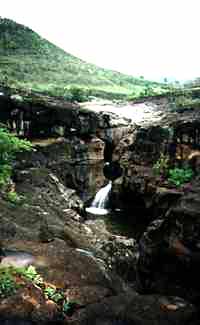
These waterfalls finally crash down into the main pool,
and the Waghora winds its way through the gorge on its way to the sea.
The Seven Pools from the top of the gorge.
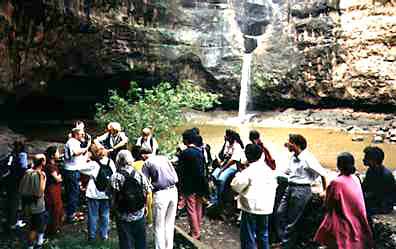
The 1996 seminar at the base of the
Seven pools, and the start of the gorge.
Other sites are also visited during the seminar if there
is time, usually including Ellora and Aurangabad. Where you go will be determined
by the interests of your group and the availability of rooms at desired
locations, time, and transportation. In 1996 (three week seminar) we visited
Ellora, Aurangabad, Pitalkhora,
Elephanta, and Kanheri. In 2000 (one-week seminar),
we went to Pitalkhora and Ellora.
The 2002 seminar will include Ajanta only- but I recommend
making arrangements to see Ellora and Elephanta!
HOW DO I APPLY?
If you are interested in participating in the Ajanta Site
Seminar, please email me at sri@devi.org
and I will forward your name and contact information to Dr. Spink. You will
recieve an application and packet of information about preparing to head
to India.
No previous experience is necessary, but space is limited,
so genuine interest in Ajanta is required. You will be interviewed directly
by Dr. Spink as part of the selection process, although this interview process
may not be in person.
HOW MUCH DOES IT COST?
The Seminar has been suspended indefinitely.
The 2003 seminar is seven days, and the cost is $375 for
non-Indian student participants. This includes your room (double  occupancy), your food, transportation
to the sites during the seminar, entertainment, and some miscellaneous costs
(like mosquito coils and the like). Non-students fee is $800, which includes
a contribution to the Harisena Trust.
occupancy), your food, transportation
to the sites during the seminar, entertainment, and some miscellaneous costs
(like mosquito coils and the like). Non-students fee is $800, which includes
a contribution to the Harisena Trust.
The seminar fees must be paid in advance, and by JUNE 15,
2003. They must be paid directly to Dr. Spink. Please email
me for the official advisory to get that information.
You are responsible for your airfare to and from India,
as well as travel costs to Fardapur and from Bombay (Mumbai). In 1996, with
a student discount, my airfare was $1300 to and from Mumbai, plus $70 to
Aurangabad and Fardapur. In 2000, the ticket to Bombay was around $1500,
plus I took a train out to Jalgaon using an IndRail Pass (not worth it if
this is the only train you will be taking). If you need more specific information
and would like more current figures, please contact your travel agent.

TIPS FOR THE SEMINAR
1. Do the background reading, even if you've read the books
and articles before. No good going all the way to India without knowing
what you're going to study.
2. Be sure you have a valid passport, with a visa. CHECK
THE EXPIRATION DATE OF YOUR PASSPORT AND VISA. You should get a TOURIST
visa, not a student visa. Contact the embassy or India Consulate in your
area for an application.The number for the US Indian Embassy (Washington,
D.C.) is 202-939-7066, website http://www.indianembassy.org/.
Don't forget to sign the picture(s) you send to the consulate.
3. If you are staying a little over the program end in
Bombay, you can arrange to have a room reserved for you at the YWCA, which
is  clean and inexpensive,
and very near shopping, the Prince of Wales Museum, the Gateway, and the
boats to Elephanta. However, you must pay for the room in advance. Cost
information for these rooms is available from Dr. Spink.
clean and inexpensive,
and very near shopping, the Prince of Wales Museum, the Gateway, and the
boats to Elephanta. However, you must pay for the room in advance. Cost
information for these rooms is available from Dr. Spink.
4. Be sure to get your immunizations up to date. Get a
malaria preventative. Be especially vigilant about your Tetanus-Diptheria
inoculations, and your Hepatitis shots. Although there is an excellent physician
in Ajanta Village (about 10 minutes from Fardapur), you want to avoid problems
as much as possible.
5. Bring enough money for shopping and extra drinks. Although
traveler's checks are recommended, they can be difficult to cash. Get some
cashed at the airport. **You must exchange your rupees in back to cash in
the airports BEFORE you go through the detectors to the gates. Rupees are
not hard currency and will not be exchanged elsewhere.
6. Bring a camera. Bring lots of film. Bring film that
can be used in the dark (400+. I even got a roll of 1600, turned out to
be a great idea.) Film is available in India, but it is expensive. Ditto
for batteries. Put your film in heavy traveling envelopes (usually found
in camera shops.) You want film for dark areas because in many of the caves,
particularly the Ajanta caves, you cannot have a flash and you cannot use
a tripod. Do not bring video cameras. You have to pay extra and sometimes
have a special permit to use them at the sites, and video is not allowed
inside the caves at all.
7. Bring a flashlight. The caves are dark, especially in
Ellora,  Aurangabad,
etc. Don't forget extra batteries!!!
Aurangabad,
etc. Don't forget extra batteries!!!
8. For the summer session, bring a small, collapsable umbrella,
and clothes that can get wet and dirty. You are going to be in Ajanta during
or at the very end of monsoon, because there aren't so many tourists crowding
the site, and the temperature is more comfortable (and everything will turn
green and gorgeous). However, it does rain. A lot. Creating a good bit of
mud.
9. Bring good walking shoes or sandals, you'll be doing
a lot of walking, climbing, etc. Also, beware of shorts- opt for "the
kind your grandmother would approve" or light pants instead. Most Indians
do not wear shorts.
10. Bring your own medicine kit and first aid kit, including
aspirin, Pepto Bismol, SUNSCREEN, and good mosquito repellent. Although
you will not generally be in the sun for long periods, those periods can
be very bright and burn you very quickly. You'll be having too much fun
to want to deal with sunburns. Floppy hats are available very cheaply at
the site, but you may not have time to buy one right away. Also, if you
generally use a lot of toilet paper, bring extra rolls with you. TP is widely
available in India, but you may have to ask for it.
ask for it.
11. The "Boil it, Cook it, Peel it or Forget it"
maxim also goes for Indian water. Do not drink bottled water in India; if
you must, make sure the seal is intact. Even in the United States, about
1/3 of the bottled water you buy is contaminated with bacteria. Dr. Spink
hires a young man from the village to boil all water, and you may drink
lots of sodas at the caves, and lots (and LOTS) of chai. If you can't have
sodas, one of the young men Dr. Spink hires brings boiled water to the caves
with us. (Be advised that boiled water is always warm. Although the MTDC
folks will sometimes chill the boiled water for you, don't count on it.)
12. Bring gifts. Dr. Spink will be hiring several village
men to help you; think of them before you go! Small and medium adult-sized
shirts, sunglasses, cups and saucers (especially expresso cups), chocolate
(wrap it well, it may melt) and other candy, old blue jeans, pens, and metallic
barrettes for the wives and sisters do very well. Don't bring large items
that might get you delayed in customs. Bring some extra money in case you
want to tip them something extra (tipping is, however, included in the cost
of the seminar).
13. Bring music. While you're relaxing in the evening together,
you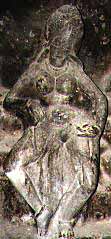 may want some; and
the village men love to dance. Bring some tapes to share (I recommend copying
your tapes and bringing the copies).
may want some; and
the village men love to dance. Bring some tapes to share (I recommend copying
your tapes and bringing the copies).
14. Bring a small backpack to carry things like flashlights,
notebooks, pens and pencils, your camera and extra film, water, your umbrella,
etc. up to the caves with you. There will lots to see, lots to do, and lots
to note down.
15. If you are female, bring feminine supplies. Include
them in your backpack. They are not impossible to get generally, but they
are ABSOLUTELY NOT available at the caves.
16. If you have an opportunity to do something, do it.
Go to the different monuments. Take the field trips to other sites. Go see
the village. Go do "extra research" at the caves. Go for long
walks (the Caves are within walking distance to Fardapur). You can sleep
or write or what-have-you later.

 Want to know more? Email us!
Want to know more? Email us!



 Ajanta
site. There are also supplemental trips to other nearby monuments if
there is time. The seminar is generally geared for students on a graduate
level, but everyone is welcome to apply; no degree or background is required.
You will be given information on background reading. There will be students
from all over the world participating, including India.
Ajanta
site. There are also supplemental trips to other nearby monuments if
there is time. The seminar is generally geared for students on a graduate
level, but everyone is welcome to apply; no degree or background is required.
You will be given information on background reading. There will be students
from all over the world participating, including India.



 occupancy), your food, transportation
to the sites during the seminar, entertainment, and some miscellaneous costs
(like mosquito coils and the like). Non-students fee is $800, which includes
a contribution to the Harisena Trust.
occupancy), your food, transportation
to the sites during the seminar, entertainment, and some miscellaneous costs
(like mosquito coils and the like). Non-students fee is $800, which includes
a contribution to the Harisena Trust. 
 clean and inexpensive,
and very near shopping, the Prince of Wales Museum, the Gateway, and the
boats to Elephanta. However, you must pay for the room in advance. Cost
information for these rooms is available from Dr. Spink.
clean and inexpensive,
and very near shopping, the Prince of Wales Museum, the Gateway, and the
boats to Elephanta. However, you must pay for the room in advance. Cost
information for these rooms is available from Dr. Spink. Aurangabad,
etc. Don't forget extra batteries!!!
Aurangabad,
etc. Don't forget extra batteries!!! ask for it.
ask for it. may want some; and
the village men love to dance. Bring some tapes to share (I recommend copying
your tapes and bringing the copies).
may want some; and
the village men love to dance. Bring some tapes to share (I recommend copying
your tapes and bringing the copies).
 Want to know more? Email us!
Want to know more? Email us!